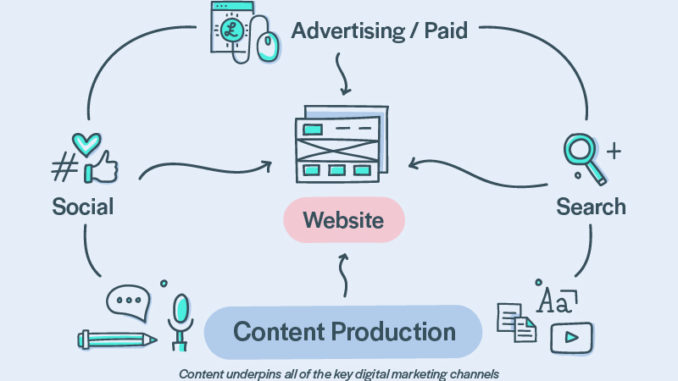
“Content is king”. I’m sure we have all heard of this phrase. I first noticed this term being used a lot back in 2009 – 2010 but it’s still relevant and something we find ourselves explaining to clients today. This blog post explains why content underpins all digital marketing and why it should probably be prioritised in your digital marketing strategy.
Content is ubiquitous. It’s essential in digital for two main reasons – social media and search marketing. In order to succeed in either of these channels, you need to have stuff to share on social and stuff to appear in the search results. This “stuff” is content but not any old bit of content will do. Content marketing helps to ensure that your resources are channeled effectively and that you’re producing content which is useful, relevant and interesting to your target audience.
How does content affect SEO?
Search engines are question-answer machines and they can only show a corresponding result when there are pages with relevant content (text, video, images). If you want to appear for particular keywords, then you need to have relevant content around that topic. This is why many websites need to build out their landing pages, refine FAQs or create a blog strategy.
How does content affect social strategy?
Social media is an engagement tool, sure. If we’re being honest though, most of the time we only want our customers to engage because it’s a stepping stone in the conversion funnel to do something else – make a purchase, sign up to an email, increase brand awareness to a new audience, etc.
In order to develop engagement and then convert, you need to hook users into your offering and unfortunately people just don’t like being sold to the way they used to – especially on social media. Rather than be told a product is great, they want to see that a product is great. It needs to be demonstrated in a video, it needs to have clear reasoning and rationale behind the design and it needs to be used in the context it’s meant to. Customers want to see who else is using the product and understand why they should be supporting that brand over another one selling something similar. All of these elements are pieces of content that have been stylised to reflect the brand values and then seeded in social media.
How does content affect advertising?
Social media and mobile technology has transformed the way we browse and absorb information. We receive everything through a newsfeed, whether it’s Instagram, Facebook or the BBC app. This habitual scrolling means that we prefer adverts that blend in or are “native” to the user experience. Awkward pop-ups that are difficult to close or banner ads that take up too much space – essentially any paid ads that don’t match the look, feel and function of the media format in which they appear and provide a bad user experience – are the opposite of native advertising.
So how do you ensure that your adverts attract the right people? As mentioned before, do less of a hard-sell and instead share a story about the brand. Story-telling is more tricky to do in traditional ad space but on social platforms we can promote long-form blogs, use video and we can show consumers who else in their circle likes that brand or business.
How does content affect my website?
As you can see, content touches on everything and we need a lot of it to satisfy the high consumption from consumers. It’s placed all over the internet for people to discover but there needs to be a central source that will keep everything nicely organised and easy for search engines to find – generally speaking, this is your website: the mothership that houses all of your content.
Summary:
A good digital team will work to ensure that your content isn’t a one-hit wonder. It can be repurposed, reshared and revised to give it a longer shelf life. While there are lots of channels that content can sit on, a clever tactic is to ensure that there is always a central hub where it can be stored in the background and that it will keep adding digital clout to your business.
Sometimes, it’s easy to get caught up in the day to day of running a business and neglect producing more content but this is not advised. Content production needs to be prioritised and then you need to ensure you have the right people to leverage it effectively. Each time a piece of content is produced and published, it’s another flag in the sand for your business. You may not know exactly who will discover it, whether it will be today or tomorrow or next year but if you have a clear strategy, there’s a high chance that the type of person you need to find it will do so eventually.
